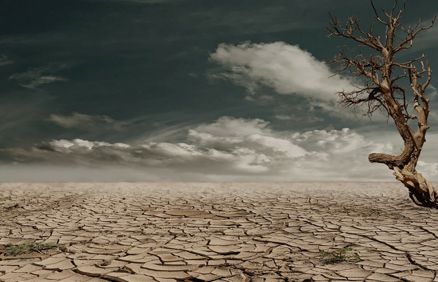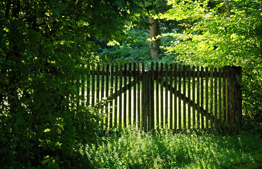Parashat Bamidbar: The desert: not a place for (land-dependent) mitzvot

While the desert isn't a suitable venue to infuse G-dliness into the world of action, it can prepare the nation before its entry into the confusing "real world." Shavuot is the holiday of bikurim, which are also brought (miderabanan) from East of the Jordan River, which we will explore here.
Once Rabbi Tzvi Yehuda Kook was asked by a young disciple if he should leave the study hall to teach and influence others. Rabbi Tzvi Yehuda had been pouring himself a cup of water from a jug; instead of stopping when the cup was full, he kept pouring until the water overflowed. In this way he wanted to explain to his disciple that first and individual needs to fill up with Torah so much that Torah overflows from him on its own, and one can go out and teach others.
It is fascinating that despite the fact that our Torah is all about conducting ourselves in our everyday lives, and its uniqueness lies in that it infuses G-d's will into earthly, everyday life, it was given in the desert. Moreover, the vast majority of the parshiyot of the Torah were told over and occurred (as events are concerned) in the desert. The desert is a place disconnected from human settlement, and in the case of the Jewish People, it was as if they were living an ongoing Shabbat experience: they didn't have to go out to work; all they needed to do was to learn Torah from Moshe rabbeinu, who received it from G-d.
Laws pertaining to life and death, monetary matters, Shabbat, holidays, kashrut, and family purity applied to a great extent in desert. However, a unique aspect of the Torah, its ability to reveal the G-dliness latent in the soil—the land-dependent mitzvot—were not at all relevant in the desert. On the one hand, the most awesome Divine revelation occurred in the desert, at Mt. Sinai; but much of its practical application did not take place there. There is no doubt that there is a major fundamental issue here that that we need to understand, with G-d's help.
It seems that by taking the Jewish People through this route, G-d wants to teach us the way to run our lives. We must first fill ourselves with Torah, refined character traits, fear of Heaven, and other good things when we first begin our lives. But this is not our main job in life. The real work begins when we enter the "real world." In this arena, we are supposed to use all the tools that we acquired during our formative years when we constructed our spiritual world, so that we can reveal G-dliness in life. Of course, this is the optimal path for most people. Certainly there are those who should stay immersed in the world of Torah for their entire lives, and not enter the "world of action"—even to become rabbis and teachers. On the other hand, there are those who never merited to have a "desert" period in their lives; they were thrown directly into life, but as they went along were able to, thanks to a strong will and Divine assistance, to build up their spiritual world and thus rectify the world around them. However, the last two paths do not suit most people; most would not feel happy this way, and it seems that this is not what G-d wants of them.
Caution! Beware of Reality
Here is the room for the question: why is this? Why are the other two paths not the ideal route?
The first path, of immersion in total sanctity disconnected from the world of action, it is clear why it isn't recommended for the masses. G-d created the world because He wanted an abode in the physical world. He desires to reveal His name in the world and eventually achieve a state where the entire world, as it were, cries out that G-d is its master. To this end, there is a need for people of Torah to live and interface with the everyday world—each person to the extent and area that they can.
The reason that the second path is not optimal is different. The physical world is deceiving, and extremely so. We live in a world where the predominant values and desires that drive it seem to be very real in our earthly eyes. To survive in such a world, while retaining an internal G-dly truth—and certainly, to be able to scream that the Emperor has no clothes—is exceedingly difficult. Before diving deep into the world, we must prepare ourselves for this encounter. Many have naively and prematurely embarked on this journey, with the intention of "influencing from within." In the end, though, they the ones who are influenced by their surroundings.
To prepare for the encounter with the world of action and with the blessed, but very earthly soil of the Land of Israel, a training period is necessary. A farmer who needs to rest from his labor one day of the week during the crucial sowing and reaping seasons, or to take a Sabbatical for an entire year during shemita, and be oblivious to whatever anyone else has to say—is no simple feat. Serious preparation is necessary.
One of Jerusalem's Talmudic geniuses was Rabbi Yoel Moshe Solomon. Many believed that he would be Jerusalem's next chief rabbi. Rabbi Yoel Moshe, however, was undoubtedly raised on the teachings of the Vilna Gaon and his disciples, who established the Yishuv of the Perushim in Jerusalem. He firmly believed that the way to bring the Redemption and rectify the world was firmly rooted in the world of action. After many years of intense Torah study, he traveled to Germany, where he studied lithography (stone press), returned to Palestine and opened a Hebrew press, where he published (together with two partners) the first Hebrew-language newspaper, HaLevanon, which became the mouthpiece of the Yishuv. Later on, he took an active role in establishing the new neighborhoods outside of the Old City: Nachalat Shiva and Me'ah She'arim, and even established the Mother of Colonies, Petach Tikvah. Of course, this did not stop him from learning and teaching Torah, giving Torah classes to the public or teaching his sons while tilling the field. Later on, when the colony was in financial straits the colonists turned to Baron Rothschild for assistance. Rabbi Yoel Moshe was strongly opposed. He was afraid that the secular clerks of the Baron (who himself was mitzvah observant) would have a negative spiritual influence on the new colony. There is no doubt that Rabbi Yoel Moshe was a majestic figure who can serve as a role model for the proper way to serve G-d, which is so critical for us now in the generation of Redemption.
The Eastern Bank of the Jordan
"These bring [bikurim] and recite from Atzeret until the Festival, from the seven species, from fruit grown on the mountains, dates grown in the valleys, and from oil-olives from the other side of the Jordan. Rabbi Yose the Galilean says: one does not bring bikurim from Transjordan, since that is not a land flowing with milk and honey" (Rambam's version of Bikurim 1:10).
Bikurim at a time of joy from the land flowing with milk and honey
Shavuot (=Atzeret) can be considered the New Year for bikurim. On this holiday, the shetei halechem (two loaves) are offered from the wheat harvested around this time (for which reason is called chag hakatzir, the Festival of Harvest). The period between Shavuot and Sukkot (=the Festival) is the time when fruits are harvested and man rejoices, as stated in the parashat bikurim, "and you shall rejoice in all the bounty that G-d your L-rd has bestowed upon you" (Devarim 26:11). This is the time when it is possible to bring bikurim and also read the parashat bikurim. There is also another, later period when it is possible for bring bikurim, from Sukkot to Chanukah. However, this is not such a time of joy, so it is possible to bring the bikurim only, but not to recite the text.
The choiciest fruits are selected for the bikurim. For most fruits, these are the fruits that grow in the hills. However, for dates that need ample heat the valleys are conductive for growing Grade A dates. There is a dispute between the first Tanna (tanna kama) and Rabbi Yose the Galilean regarding whether it is possible to bring bikurim from the Eastern bank of the Jordan river. The first Tanna learns from the verse in parashat habikkurim "And He brought us to this place and gave us this land, a land flowing with milk and honey" (Devarim 26:9), that this excludes Transjordan. Since this area is not considered "a land flowing with milk and honey," first fruits should not be brought from here. In practice, Rambam holds (Hilchot Bikurim 2:1) that bikurim are brought from Transjordan, but as a rabbinical injunction.
Transjordan
The eastern bank of the Jordan River is a vast area and includes several regions: Golan, Gilad, Moav, and Edom. In the times of Chazal, the Golan was considered part of the Galilee, while Edom was not on the eastern part of the Jordan, but rather on the eastern bank of the Arava River. That is to say, that when Chazal discuss Transjordan (ever hayarden), their intent was primarily the mountainous Gilad and the plains of Moav (the fields of Moav we read about in Megillat Rut). Transjordan is mentioned in tractate Shevi'it (9:2) as one of the regions relevant to bi'ur for kedushat shevi'it fruit (destroying or getting rid of sacred fruit at certain times). It seems that it was considered more important than the Galilee, since it appears in this this list (like in other places), after Judea.
The Jewish settlement in Transjordan was strengthened when the Hasmoneans conquered the area. In most of these places, Jewish presence was discontinued following Bar Kochba's Revolt, with the exception Tzoar, near the Dead Sea. Tzoar is situated on the southern side of the eastern bank, and there was Jewish presence in the area in Mishnaic and Second Temple times. A Jewish cemetery was discovered in Tzoar dating back to the Byzantine era (4th and 7th century). On the tombstones, aside from the name of the deceased, the epigraph noted the year since the destruction of the Second Temple, as well as the year in the shemitta cycle. Even in the 11th century, we find in the Cairo Geniza a reference to the Beit Din of Tzoar. From the Crusader period and on, we have not found evidence of Jewish settlement in Transjordan. In truth, the non-Jewish settlement there was also scarce. The place became desolate (perhaps this is yet another proof that it is an integral part of the Land of Israel – "I will make the land desolate, so that your enemies who settle in it shall be appalled by it," Vayikra 26:32), and there were no major cities there. Even Rabbat Ammon, the ancient capital of Ammon (today Amman, the capital of Jordan), was just a small village.
Since in the eyes of the Jews, the Land of Israel included both banks of the Jordan River, early activism on behalf of the Land of Israel included attempts to settle the Eastern bank of the Jordan River and establishing a yeshiva there. The British, however, as one of the initial measures they took against the Zionist movement in the early British Mandate Period, was to rip Transjordan from the Jewish national homeland. They then gave it over to Abdullah al-Hussein, of the Hashemite dynasty, whose sovereignty had extended before to the Hejaz area, just west of Saudi Arabia. This is how the Hashemite Jordanian kingdom was formed, now modern Jordan. What can we do? In the meantime, visiting the ancestral portions of Reuven, Gad, and half of Menashe, as well as the tombs of Aharon and Moshe (or at least to the general area, since we don't know the exact site of the latter)—those who gave us the Torah—involves crossing over the borders into another country.




